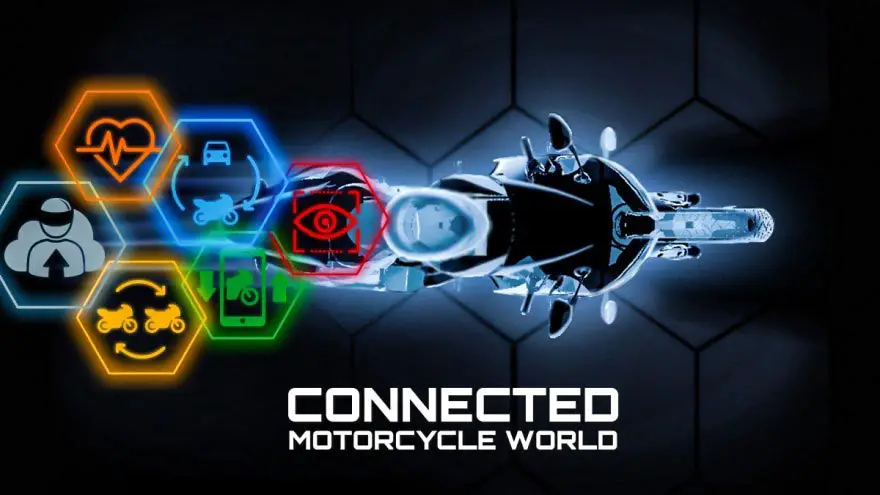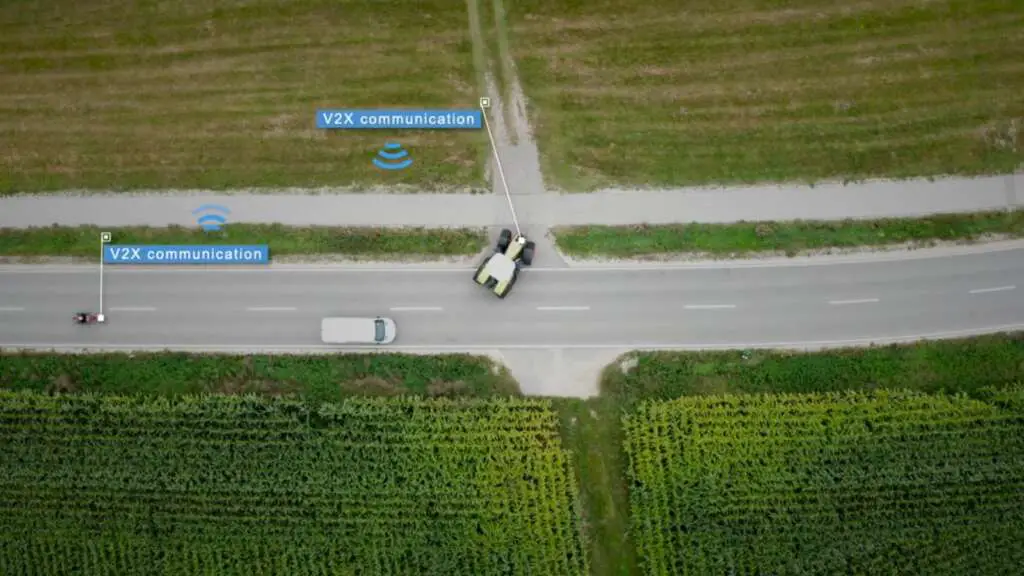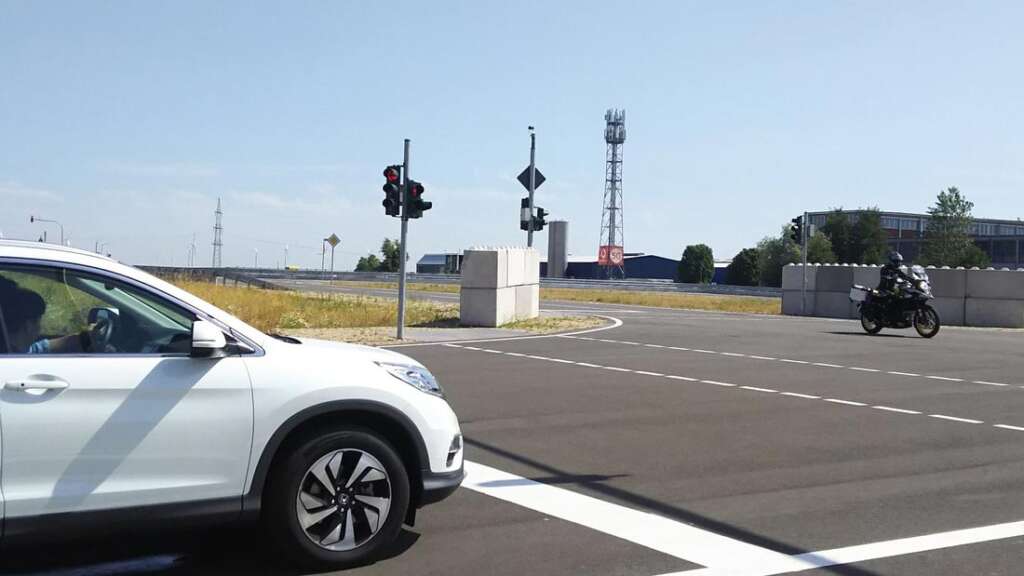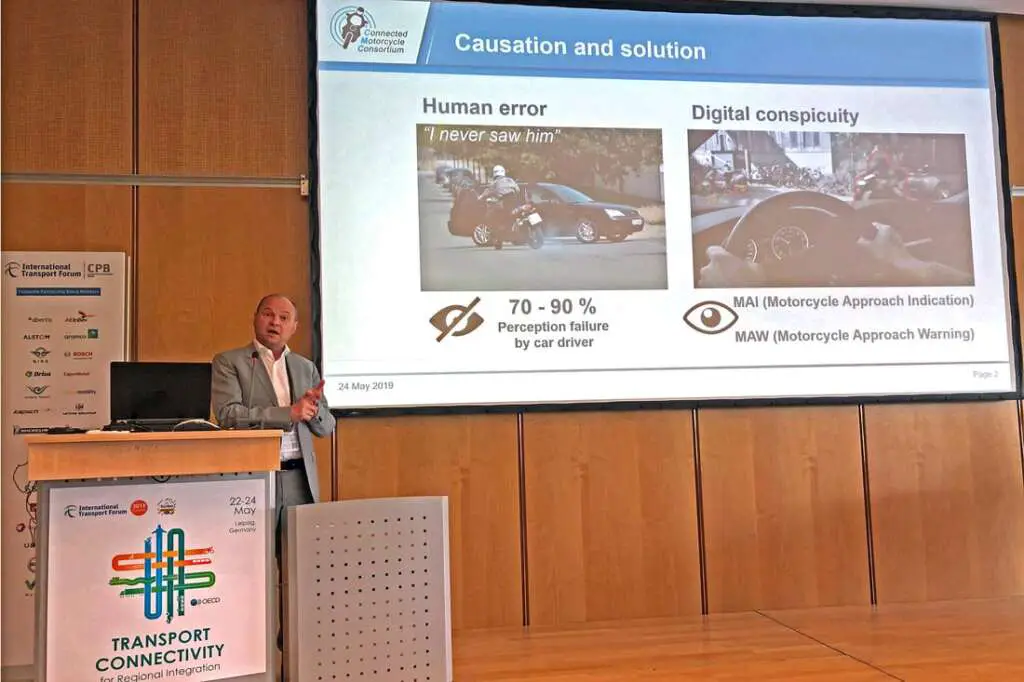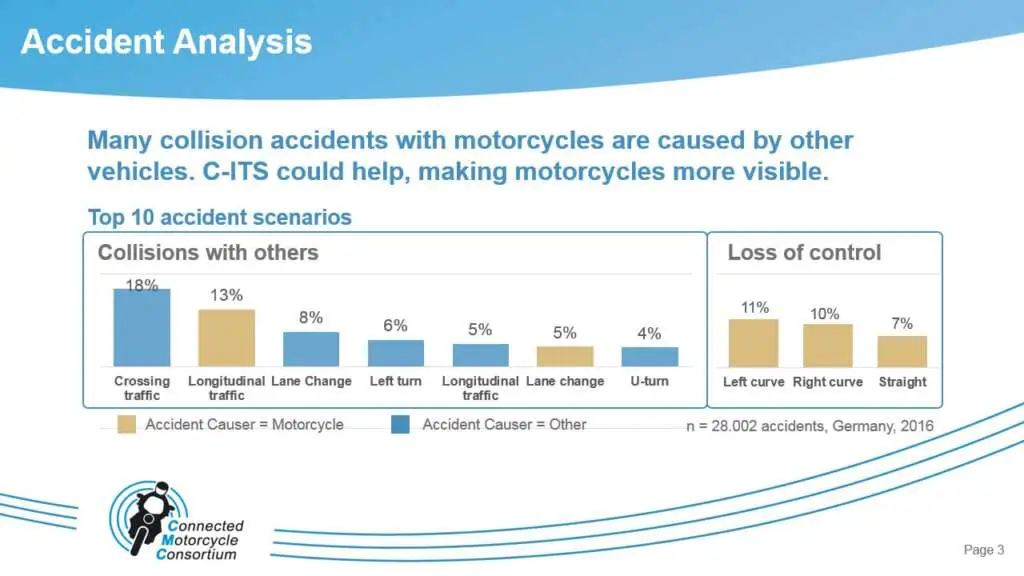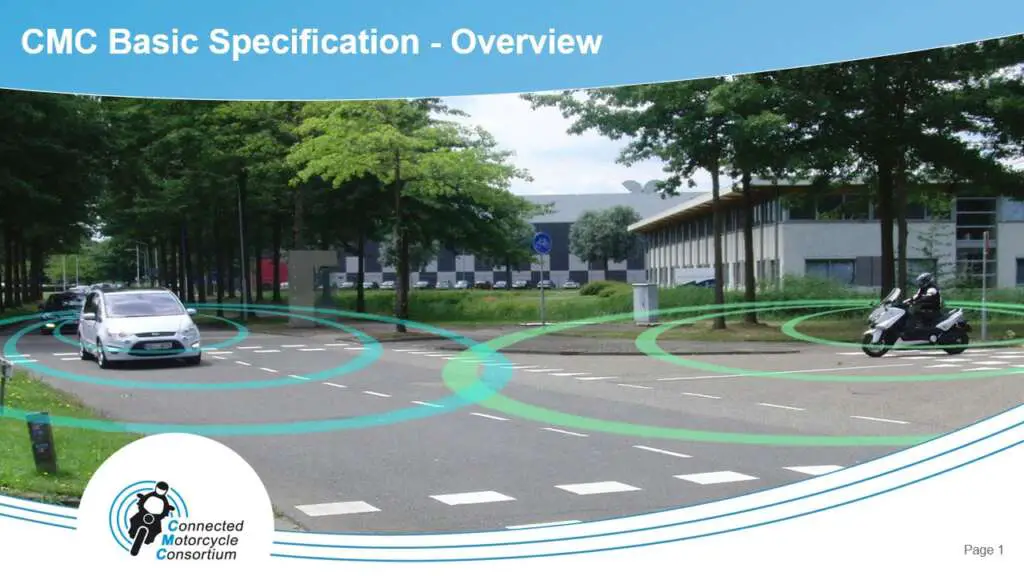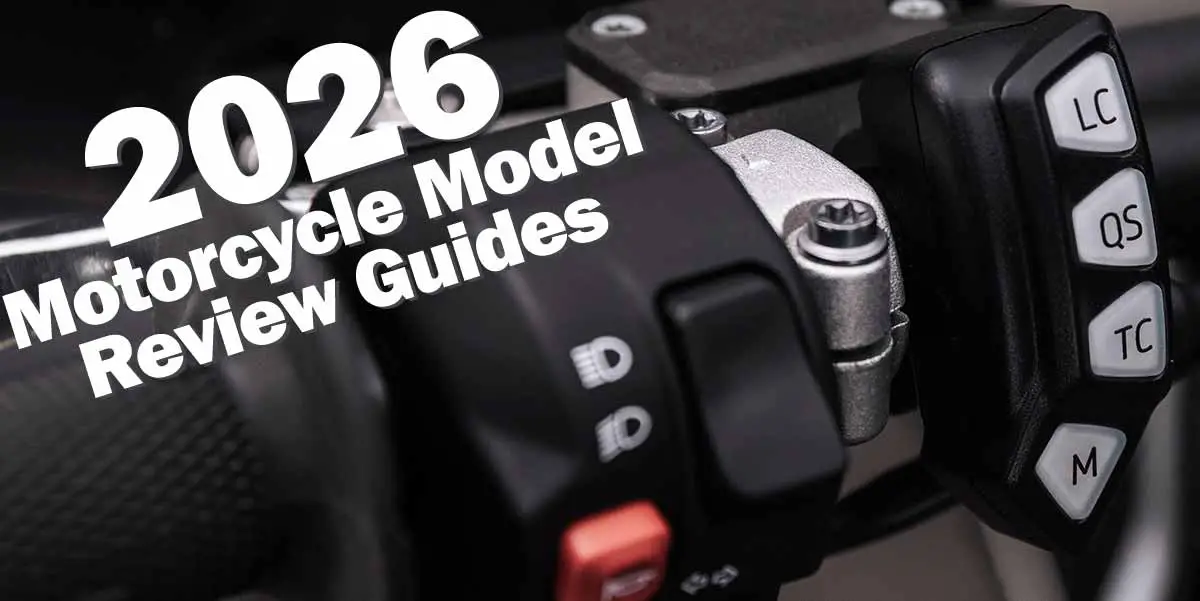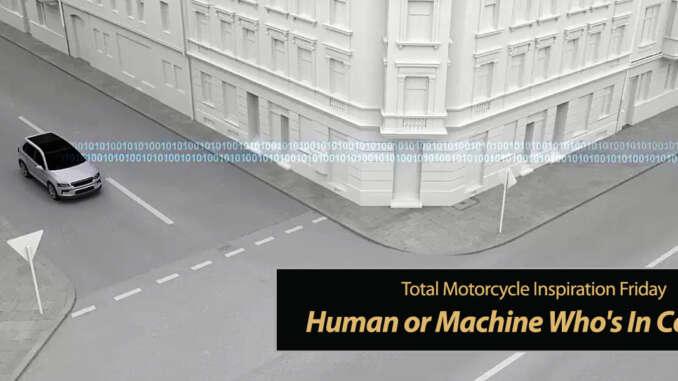
This week’s Inspiration Friday: Human or Machine Who’s In Control? TMW examines this touchy subject of who is in control of your bike, you or the computer? With Artificial Intelligence connecting cars and bikes and Human Machine Interfaces removing human errors will you be allowed to ride naturally ever again or is this a good thing? The Connected Motorcycle Consortium, with members BMW, Honda, KTM, Yamaha, Ducati, Suzuki, Triumph and Kawasaki use built-in AI to focus on further improvements of the Basic Specification for motorcycles, while at the same time taking account of new functions supported by on-board sensors both in cars and in motorcycles. It will be intrusive to riders and drivers. It will prevent you from making “mistakes” the HMI (Human Machine Interface) doesn’t think you should do.
Everything that is on the road, cars, bikes, motorcycles, even tractors will have this basic (yes, it’s a basic standard) installed in them so they can all “talk” to each other independent of you, the rider, driver or operator*.
At Total Motorcycle we are all in favor of added safety for riders and preventing accidents 100%. This is just a really, really tough call as it isn’t just ABS, traction control or a riding mode, this is the rider giving up control of the vehicle in hopes the HMI will make the right decision at the crisis point. Remember the safety advice of not putting your bike in neutral at a stop light/sign just incase a driver behind you doesn’t stop and you need to accelerate into an intersection… ya, the bike may not let you do that now.
Something to think and read about…
*Maybe rider, driver or operator verbs are now outdated, who needs a steering wheel or handlebar anyways?
BMW Motorrad expands cooperation in the Connected Motorcycle Consortium (CMC)
For decades, BMW Motorrad has been leading the way with regard to improving motorcycling safety. ABS, Dynamic Traction Control (DTC) or Automatic Cruise Control (ACC) with radar-based distance regulation are just a few examples of the innovative strength of BMW Motorrad when it comes to motorcycle safety. This topic is the focus of the Connected Motorcycle Consortium (CMC), a cross-manufacturer consortium for motorcycle safety founded in 2016. As a founding member of the CMC, BMW Motorrad will continue to work together with other renowned manufacturers to further increase the safety of motorcycling and to make riding pleasure on two wheels even safer and more attractive.
CMC continues after milestone achievement
Motorcycle manufacturers in CMC signed an agreement in December 2020 to continue cooperation 2021 onwards to further enhance motorcycle safety and assure that motorcycles maintain their role in future mobility. BMW Motorrad, Honda Motor Co., Ltd., KTM AG, Yamaha Motor Co. Ltd, Suzuki Motor Corporation and Triumph Design Ltd. expressed their intention to support the common activity in CMC ‘Next’.
The approach is widened and the work will include investigating conspicuity of motorcycle by ADAS systems (Advanced Driver Assistance System). This ‘system’ approach looks at creating synergies between on-board sensor systems and connectivity.
CMC members consider safety as a goal for the industry and are in favour of a strategy on improving motorcycle rider’s safety.
CMC Basic Specification as milestone
Since its establishment in 2016, CMC has worked on a Basic Specification for motorcycle specific V2X* connectivity systems. CMC has launched this ‘CMC-Basic Specification’ on Dec 11th 2020. The Basic Specification is a first step to describe the function of motorcycle V2X systems. In a further step beyond 2020, the participating manufacturers will define further essential functional requirements to standardise in detail.
CMC-BS documents are available for download on the CMC website
CMC ‘Next’ increases cooperation with car & other vehicle industries
A further crucial step for CMC ‘Next’ after 2020 is the cooperation with the car industry and other vehicle manufacturers since motorcycles shall communicate in a standardised way. Modern cars are increasingly equipped with on-board sensor systems (radar, camera, etc.) and driver assistance systems. These vehicle systems need to include motorcycle requirements in order to enhance their safety effects in case of mixed traffic with motorcycles.
CMC believes that tailored motorcycle/car scenarios and tests need to be developed and standardised.
The new organisation has started its activity in January 2021. The six motorcycle manufacturers encourage other motorcycle manufactures, suppliers, Car manufactures and the other related organisations to join the cooperation to further pursue the deployment of new elements for motorcycle safety.
As a motorcycle and car manufacturer, the BMW Group has a twofold interest in CMC NEXT’s topics and sees particular opportunities for synergy in this dual role, especially in the area of onboard sensor technology. BMW Motorrad plans to use rider assistance functions to improve motorcycle safety and, as part of CMC NEXT, work towards ensuring that both V2X systems as well as the onboard sensor-based systems of motorbikes and cars work hand in hand and are not used as stand-alone systems.
* V2X in terms of wireless communication technology stands for ‘Vehicle-to-Everything’, including ‘Vehicle-to-Vehicle’ and ‘Vehicle-to-Infrastructure’.
*the term ‘motorcycle’ in this text covers all types of Powered Two Wheelers (PTW)
Yamaha Motor continues to cooperate with other motorcycle makers in the Connected Motorcycle Consortium to improve safety
Yamaha Motor believes that motorcycles* have a great potential as an enjoyable and practical mean of individual transport in the future. New elements of safety for the company’s products is a focus in Yamaha developments.
Yamaha Motor signed an agreement in December 2020 with other world leading motorcycle manufacturers to continue cooperation 2021 onwards to further enhance Motorcycle safety and assure that motorcycles maintain their role in future mobility. BMW Motorrad, Honda Motor, KTM, Suzuki Motor and Triumph expressed their intention to support the common activity in CMC ‘Next’.
The approach is widened and the work will include investigating conspicuity of motorcycle by ADAS systems. This ‘system’ approach looks at creating synergies between on-board sensor systems and connectivity.
CMC members consider safety as a goal for the industry and are in favour of a strategy on improving motorcycle rider’s safety.
CMC Basic Specification as milestone
Since its establishment in 2016, CMC has worked on a Basic Specification for motorcycle specific V2X** connectivity systems. CMC has launched this ‘CMC-Basic Specification’ on December 11th, 2020. The Basic Specification is a first step to describe the function of motorcycle V2X systems. In a further step beyond 2020, the participating manufacturers will define further essential functional requirements to standardise in detail.
CMC ‘Next’ increases cooperation with car & other vehicle industries
A further crucial step for CMC ‘Next’ after 2020 is the cooperation with the car industry and other vehicle manufacturers since motorcycles shall communicate in a standardised way. Modern cars are increasingly equipped with on-board sensor systems (radar, camera, etc.) and driver assistance systems. These vehicle systems need to include motorcycle requirements in order to enhance their safety effects in case of mixed traffic with motorcycles.
CMC believes that tailored motorcycle/car scenarios and tests need to be developed and standardised.
The new organisation has started its activity in January 2021. The six motorcycle manufacturers encourage other motorcycle manufactures, suppliers, Car manufactures and the other related organisations to join the cooperation to further pursue the deployment of new elements for motorcycle safety.
Motorcycles are part of future traffic
Executive Officer Takuya Kinoshita, Chief General Manager of Motorcycle Business Operations, Yamaha Motor Co., Ltd.:
“The future traffic will be increasingly connected and motorcycles cannot stay aside. Yamaha Motor is part of such future mobility. Motorcycles need to stay a solution and remain an enjoyable mean of transport for the decades to come. This is why activities like CMC are so important for the motorcycle industry. Rider safety is one of the key pillars for Yamaha and a shared activity amongst the motorcycle makers in the safety area is a prerequisite.”
Executive Officer Toyoshi Nishida, Chief General Manager of PF Model Unit, Yamaha Motor Co., Ltd.:
“We are aiming deployment of connectivity for motorcycles to enhance safety and at the same time to ensure riding comfort and riding pleasure by integrating motorcycles into a future traffic ecosystem.”
* The term “motorcycle” in this text covers all types of Powered Two Wheelers (PTW)
** V2X in terms of wireless communication technology stands for “Vehicle-to Everything”, including “Vehicle-to-Vehicle’ and ‘Vehicle-to-Infrastructure”.
CMC Continues after Milestone Achievement
Motorcycle manufacturers in CMC (Connected Motorcycle Consortium) signed an agreement in December 2020 to continue cooperation 2021 onwards to further enhance motorcycle safety and assure that motorcycles maintain their role in future mobility. BMW Motorrad, Honda Motor Co., Ltd., KTM AG, Yamaha Motor Co. Ltd, Suzuki Motor Corporation and Triumph Design Ltd. expressed their intention to support the common activity in CMC ‘Next’.
The approach is widened and the work will include investigating conspicuity of motorcycle by ADAS systems. This ‘system’ approach looks at creating synergies between on-board sensor systems and connectivity.
CMC members consider safety as a goal for the industry and are in favour of a strategy on improving motorcycle rider’s safety.
■CMC Basic Specification as milestone
Since its establishment in 2016, CMC has worked on a Basic Specification for motorcycle specific V2X* connectivity systems. CMC has launched this ‘CMC-Basic Specification’ on Dec 11th 2020. The Basic Specification is a first step to describe the function of motorcycle V2X systems. In a further step beyond 2020, the participating manufacturers will define further essential functional requirements to standardise in detail.
■CMC ‘Next’ increases cooperation with car & other vehicle industries
A further crucial step for CMC ‘Next’ after 2020 is the cooperation with the car industry and other vehicle manufacturers since motorcycles shall communicate in a standardised way. Modern cars are increasingly equipped with on-board sensor systems (radar, camera, etc.) and driver assistance systems. These vehicle systems need to include motorcycle requirements in order to enhance their safety effects in case of mixed traffic with motorcycles.
CMC believes that tailored motorcycle/car scenarios and tests need to be developed and standardised.
The new organisation has started its activity in January 2021. The six motorcycle manufacturers encourage other motorcycle manufactures, suppliers, Car manufactures and the other related organisations to join the cooperation to further pursue the deployment of new elements for motorcycle safety.
* V2X in terms of wireless communication technology stands for ‘Vehicle-to-Everything’, including ‘Vehicle-to-Vehicle’ and ‘Vehicle-to-Infrastructure’.
* * the term ‘motorcycle’ in this text covers all types of Powered Two Wheelers (PTW)
■Yoshishige Nomura | Operating Executive, General Manager, Monozukuri Center, Motorcycle Operations, Honda Motor Co., Ltd.
“In order to make solid progress with motorcycle safety with C-ITS, communication with the automobile industry and road infrastructure are vital. Through our ongoing CMC ‘Next’ activities, we will expand on the basic specification to include connectivity, low-cost and vehicle-compatibility to enable adoption in production vehicles, and by cooperating with industry bodies including the automobile industry, aim for a society which connects more road users with each other.”
Total Motorcycle would like to thank CMC and its members for inspiring us to bring you this week’s Inspiration Friday: Inspiration Friday: Human or Machine Who’s In Control?. Each week we bring you another Inspiring Motorcycle story to inspire you to get out and ride! Thank you for your support for visiting us and supporting us at Patreon for just $1 a month.

Michael Le Pard (“Mr. Totalmotorcycle”) is the Founder of Total Motorcycle, the world’s largest motorcycle information site, trusted by over 430 million riders since 1999. With over 34 years of experience in motorcycles, gear and rider culture, he has built a global community dedicated to empowering and inspiring motorcyclists.
Total Motorcycle remains his passion project. Combining expert research, hands‑on knowledge and a commitment to helping riders make informed decisions about bikes, gear and safety worldwide.



